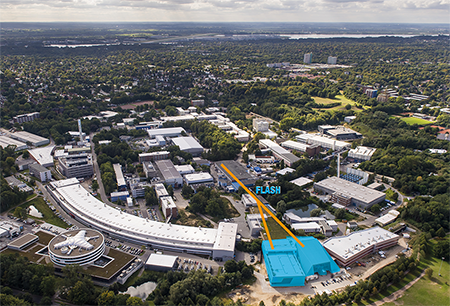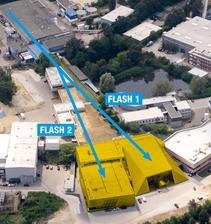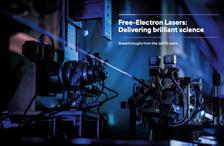FLASH (in 2018).

FLASH, the Free-Electron LASer in Hamburg, started user operation in summer 2005 as the first free-electron laser for XUV and soft X-ray radiation. It so far operated in the "self-amplified spontaneous emission" (SASE) mode and as of 2024 covered a wavelength range from 3.4 nm to about 51 nm in the first harmonic with GW peak power and pulse durations between 30 fs and 200 fs. FLASH1 offers four beamlines for users in the FLASH experimental hall 'Albert Einstein' (FL11 & FL12 [former 'BL-'] and FL14 and FL15 [former 'PG-'] beamlines).
In the recently finished second FLASH2020+ upgrade shutdown (from June 10, 2024 to August 3, 2025) FLASH1 was converted into an externally seeded FEL at high repetition rate. Presently the seeded FLASH1 is being commissioned and it will start with first 'community experiments' in spring/summer 2026.
In the past years, an additional FEL undulator line in a separate tunnel - FLASH2 - and the new FLASH experimental hall 'Kai Siegbahn' have been built adjacent to the existing FLASH facility now called FLASH1. First lasing of FLASH2 was achieved in August 2014 in parallel to FLASH1. Now the FLASH facility at DESY comprises two separate and almost independent FEL sources, with FLASH2 covering a wavelength range from 3.2 to 90 nm in the fundamental. FLASH2 presently offers three experimental stations in the FLASH experimental hall 'Kai Siegbahn' (building 28k). Since spring 2016, the beamlines FL24 and FL26 are available for users. At FL26 the permanent end station REMI, a reaction microscope from the MPIK Heidelberg, is set up. A third FLASH2 beamline, the new pulse-length preserving monochromator beamline FL23 saw first light at the beginning of 2023 and has then been commissioned. A first FLASH in-house user experiment on single-shot ptychography has been successfully conducted end of 2023 and three more user experiments in the first half of 2024.
The FLASH user facility is equipped to perform time-resolved experiments in such diverse fields as atomic, molecular, and optical physics, chemistry, condensed matter and nanoscience, life science, warm dense matter research, and FEL physics and technology, including development of new methods and instrumentation.








